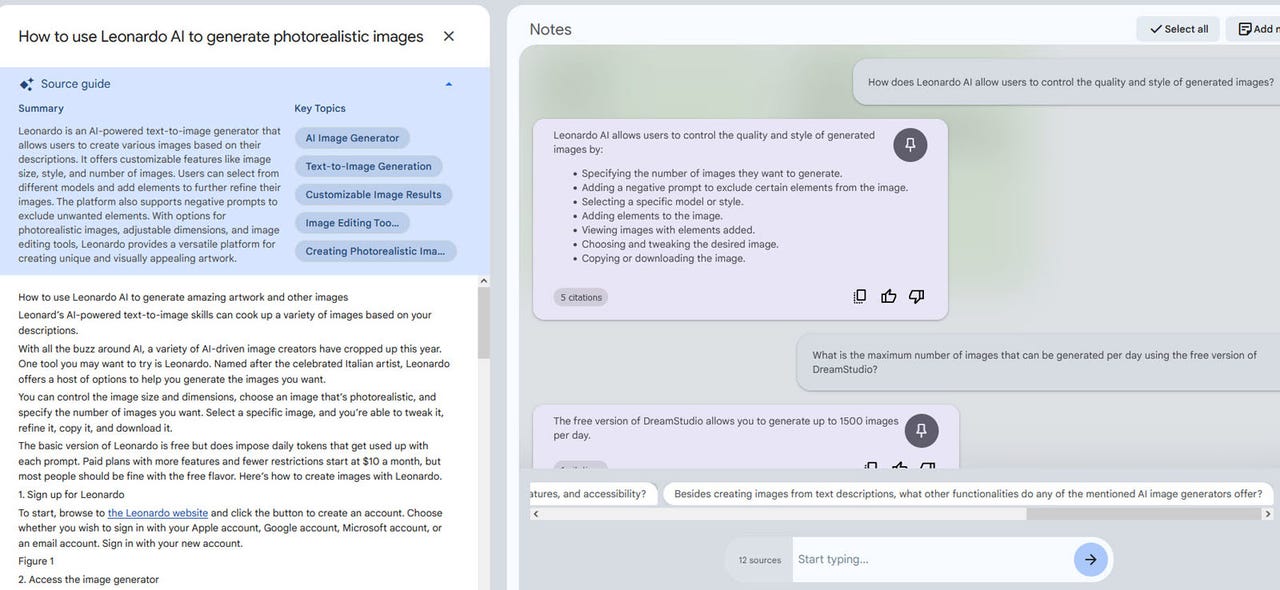How to use Google’s AI-powered NotebookLM to organize your research

Gathering and managing research for any type of project can be a daunting task as you have to try to organize the different kinds of information you collect. One tool that aims to ease the process is Google’s NotebookLM. Using AI, NotebookLM will collate the various sources of information you add, summarize the key details, and even answer any questions you ask about the research you’ve gathered.
Also: Have 10 hours? IBM will train you in AI fundamentals – for free
Available to anyone through Google’s experimental Labs service, NotebookLM acts as part note taker, part collaborator, part data collector, and part librarian. The tool works by prompting you to create a virtual notebook designed to hold all the text, documents, and other research that you compose or collect. The goal is to provide easy access to all of the information you need as you write your paper, conduct your research, or develop your project.
For now, NotebookLM is available only in the US for people 18 and over. Here’s how it works.
How to use NotebookLM
First, open the NotebookLM website in your favorite browser. You can use Google Chrome, Microsoft Edge, Firefox, or another program. Click the button to try NotebookLM and sign into your Google account if prompted.
View the Welcome page to learn how to create a notebook and access sample notebooks.
Before you create your first notebook, review the sample notebooks to learn how they’re put together. Click each of the sample ones at the bottom — Introduction to NotebookLM, Invention Of The Lightbulb, Mugifier Documents, and Westward Mushrooms.
See how the notes and sources are collected and organized and how the tool suggests potential questions to ask. Be sure to read the Introduction to NotebookLM notebook to learn how to effectively use the tool itself.
After viewing the sample notebooks, return to the Home screen. Click the button for New Notebook, name your project, and then click Save.
Your first task is to add a source that you want to use for your project or research. You can upload a Google Docs file or a PDF or copy and paste text. Let’s try a Google Doc first. Click the Add Source button in the left pane and then select Drive from the popup window.
At Google Drive, navigate to the folder containing the document you want to upload and then select it. You can select more than one document. Then click Insert.
Next, you can upload a PDF to add to your notebook. Click the Add Source button, select PDF from the window, and then click the file you want to upload.
Next, you can add copied text. Open the document or other file that contains the text you wish to use. Select and copy the text. Click the Add Source button in your notebook and select Copied Text. Paste the text in the window and then click Insert.
At any point, you can add one or more notes to your notebook. The notes can describe the project or research you’re conducting, the contents of the notebook, or questions you might want to ask about the sources and information you’ve gathered.
To create a note, click the Add Note button in the upper right, click anywhere in the New Note window, and then type your note. When done, click anywhere outside of the note to save it.
Continue setting up more sources and notes until you’ve added all the research and information you need. Click on a specific source to view it in a large pane. A source guide provides a summary of the information along with its key topics.
At this point, you may want to start asking questions to flesh out specific details in the source information. The AI built into the NotebookLM technology suggests questions based on its analysis of the sources. Click one of the suggested questions to generate an answer. You can then select any follow-up questions.
To ask suggested questions about one of the sources, click that source to open it in the larger pane. The suggested questions that appear are devoted to that specific source. Click the question you want to ask.
Beyond using the suggested questions, you can naturally ask your own questions. At the prompt, type the question you wish to ask and wait for the reply.
Finally, you can share the notebook with someone else. Click the Share icon in the upper right and enter the name or Gmail address of the recipient. Click the drop-down box next to the person’s name and decide if you want them to be able to edit the notebook or only view it. When ready, click Send to send them the link to your notebook.




